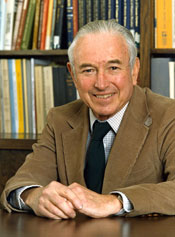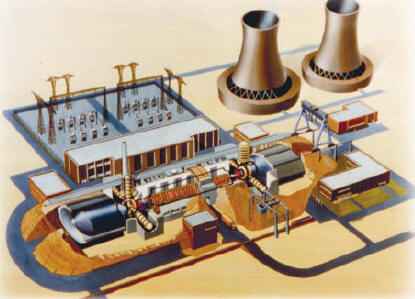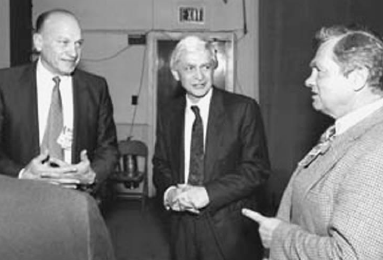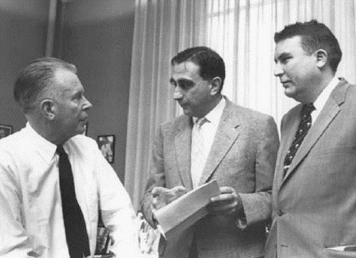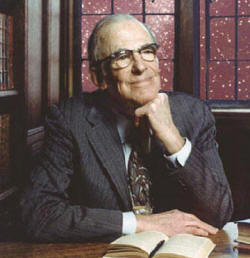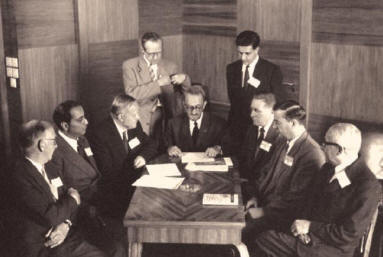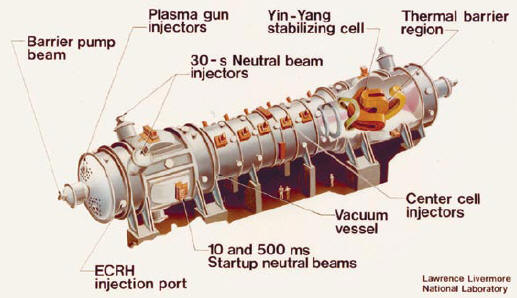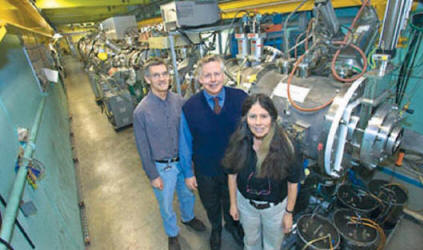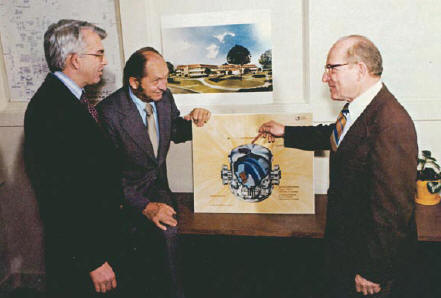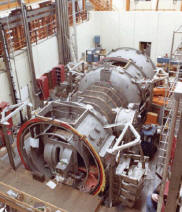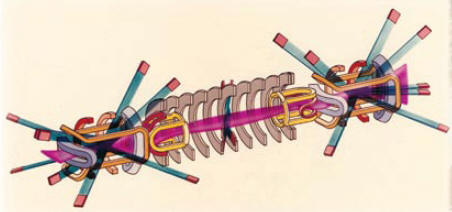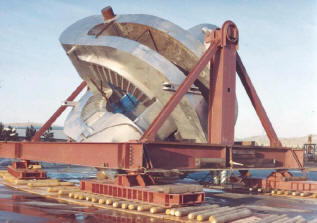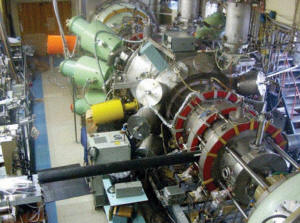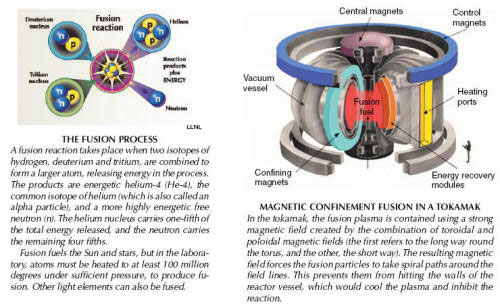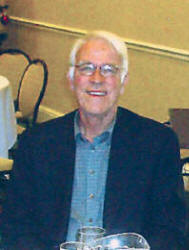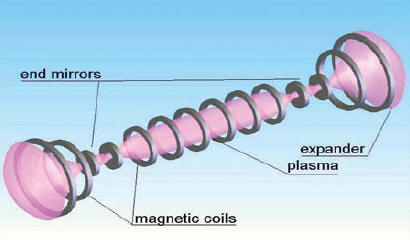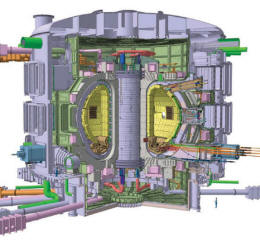|
by Richard F. Post Summer 2009 from 21stCenturyScienceTech Website
A fusion pioneer reviews 60 years of
fusion history, and proposes the axisymmetric
Artist’s conception
in the 1980s of what the larger MFTF tandem
First off, I wish to thank Steve Dean and his Fusion Power Associates for honoring John Nuckolls and me, and for giving us this opportunity to comment on a field or research that has been our passion for decades.
In my case, I would
also like to thank Ken Fowler for proposing the theme of the
symposium to Steve Dean many months ago and then diligently
following through on its details..
John Nuckolls
(center), the seventh director of LLNL, with Roger
Not about the negative aspects of history, as in “those who forget history are doomed to repeat it,” but the positive view that:
Where to begin? And what to highlight about the six-decades-long love affair that I have had with fusion research?
My fascination with fusion really began early in 1952 as a result of three classified lectures given by Herb York. I was then a year out of graduate school and working at the Radiation Laboratory (now LBL).
Herb’s series of lectures covered the physics issues of controlled thermonuclear reactions (CTR) and described the U. S. fusion programs at Princeton University, headed by Lyman Spitzer, and at Los Alamos, headed by Jim Tuck.
Both groups were working on versions of
the only game in town at that time - trying to use specially shaped
magnetic fields to stably contain a 100 million-degree-hot ionized
gas-plasma - composed of electrons and fusion fuel nuclei - heavy
hydrogen isotopes
The laser had not yet been invented and John Nuckoll’s pioneering work in the area of laser-based fusion research was yet to come.
Herb York’s lectures on magnetic fusion had a specific goal in mind - to stimulate the interest of us physicists to join him in forming a new laboratory on a site near Livermore.
This new lab was to have fusion research as one of its
main goals.
A New Laboratory Formed
To make a long story short, after Herb’s
lectures there was ferment among many of us - trying to think of
ways to solve the controlled fusion problem. Several of us then
joined the new lab, some to work on controlled fusion and others to
work on classified military applications.
Even before 1952 it was beginning to be evident that within perhaps less than a century the world could no longer count on fossil fuels for its ever-increasing energy demands, In long term it would have to rely on energy released in nuclear reactions, that is, either fission or fusion.
To those of us that went to Livermore with Herb it seemed obvious that the fusion of heavy hydrogen was the way to go, and we pointed to the world’s huge fusion fuel reserve - the fact that 1 in every 6500 atoms of hydrogen in water was a deuterium atom.
Here was a fuel reserve that was not
only virtually inexhaustible, but one that would be cheap and
universally available; no fusion OPECs and no future conflicts born
of competition for limited fuel resources.
Then think about putting that flow of water into a deuterium separation plant, using well-known energy-efficient separation techniques. From that input of ordinary water there would come out of the separation plant a small stream of heavy hydrogen - deuterium.
This deuterium, if distributed to fusion power plants and fused to completion, would represent a fuel energy input rate equal to the entire world’s energy input rate today - all the oil and natural gas wells, all the coal mines, all the hydroelectric plants - everything!
And as to inexhaustibility, how long do
you think it would take to pump all the water in the oceans through
an 18-inch water main?
Magnetic Fusion Research Begins
By 1955 it was apparent that magnetic confinement of a hot plasma was a much more complex process than first thought, so that at the 1958 Geneva “Atoms for Peace” Conference, these three countries declassified and described all of their fusion research results in order that the fusion quest could be pursued by all the nations.
The 1958 Atoms for
Peace conference in Geneva, where the United States, Soviet Union, Dr. Homi Bhabha (India), Dr. V.S. Emelyanov (USSR), Professor S. Eklund (Sweden), Professor F. Perrin (France), Dr. Homi M. Sethma (India), Contreadmiral Otacilio Cunha (Brazil), Dr. W.B.Lewis (Canada), and Dr. I.I. Rabi (U.S.)
To achieve net fusion power it is necessary to heat and then to confine a fusion plasma long enough for the fusion energy released to exceed the energy required to heat the fuel to fusion temperatures.
However, as of Geneva 1958 it was clear that the plasmas in every magnetic configuration that had been tried exhibited plasma instability and turbulence, leading to unacceptably rapid loss of the plasma.
This universal observation - of the negative effects of turbulence on magnetic confinement - defined the central problem for magnetic fusion research from that day forward, up to and including today.
First, some basics of the magnetic confinement for the non-scientists.
Strong magnetic fields change the straight-line orbits of the ions and electrons of a plasma into tight spirals moving along the field lines. This inhibits escape of the particles across the field lines, but unless something is done about it, does not restrict their motion along the field lines.
In magnetic fusion research, the choice of what that “something” should be has from its beginning separated magnetic fusion researchers into two distinct groups
But the plasma physics issues introduced by making one or the other of these choices are profoundly different, and (here comes the personal bias) the choice that was actually made, in the late 1980s, by most of the world’s fusion programs - to restrict their research to closed-field systems - has severely slowed our progress toward the fusion goal.
From Broad-Based
Program to Tokamak Only
The program was a broadly based one, with sizeable experiments investigating a variety of both closed and open systems, backed up by an extensive theoretical and computational effort. But, not surprisingly, the criterion that was adopted by the policy makers at that time for judging the merit of one approach over another was how close the magic fusion numbers - plasma confinement time, plasma density, and plasma temperature - that had been achieved experimentally came to the numbers required for net fusion power.
By the middle 1980s one closed-field system - the tokamak - was the clear winner by this criterion.
Why? Because early on, starting with experiments by its Russian inventors, it was found that all you needed to do to get better numbers out of a tokamak was to build a bigger one.
THE MFTF TANDEM
MIRROR CONFIGURATION
Though the tokamak was very
difficult to analyze theoretically, and was clearly plagued by a
variety of plasma instabilities, nevertheless when one plotted the
confinement times of succeeding generations of ever-larger
tokamaks against the square of their plasma radius the data lay
on an upward-sloping straight line - aiming directly at plasma
fusion ignition in some future, necessarily very large, tokamak.
This shift in program breadth happened even though great progress had been made in open-ended mirror systems following the invention of the tandem mirror in 1976 by Ken Fowler and Grant Logan, here at the Laboratory, simultaneously with its invention in Novosibirsk, Russia, by Dimov.
T. Kenneth Fowler
(left), Associate Director of LLNL from 1970 to 1987,
In that heyday for mirror research a large tandem mirror experiment here at Livermore, TMX, was proposed and construction was completed in 18 months.
Tandem mirror systems were also built with similar speed - at MIT and the University of Wisconsin in the US, and at Tsukuba in Japan. At Livermore TMX was followed by an upgrade - TMXU, and then by the construction of a really large tandem mirror, MFTX.
Days after its completion and first shakedown tests MFTX was mothballed and all mirror-based work in the U. S. was terminated.
Where Are We Today?
We are partway down a long trail that
dates back to 1985, when a proposal for a really large,
internationally sponsored, tokamak -
ITER - was made. It then took 20
years - until 2006 - before funding agreements (10 billion dollars)
and a site was chosen by the international partners. Another 10
years will be required for construction and 20 years of operation
are planned, after which a “demo” tokamak, one actually
generating electricity would be considered (since the ITER
experiment will generate only heat).
Here I’ll be discussing magnetic fusion only. I’ll not talk about the impressive progress in laser-based fusion towards fusion ignition - Ed Moses and his co-workers will certainly be covering that in their talks.
First, about ITER: I give ITER high marks for keeping magnetic fusion from dying on the vine, for the international cooperation it has fostered, and for the fusion-related science and technology that was developed and is being developed to implement it.
But ITER is like the TV ads for a new wonder drug:
The “side-effects” of ITER, in my opinion, have been catastrophic for magnetic fusion research.
They include:
Enough of negativity!
I would like very much to finish this talk on a positive note. First, our critical need for clean and sustainable sources of energy represents a real opportunity for fusion research if we take advantage of it.
One way to put the situation today is to talk of it in terms of “present reality” and “future reality.”
The prime example of “future reality” was when John F. Kennedy said,
He knew that the science and rocket technology needed for a moon landing was there, along with the money to pay for it.
I believe that we are in a similar situation today with respect to the magnetic approach to fusion power. We have the basic scientific understanding, the computational horsepower, and the technology to take a new, broader, look at the problem. And we certainly have the financial wherewithal. For example, we are spending 700 billion dollars a year to import oil.
One week of that rate of expenditure - 11 billion dollars - is equal to the entire U S. magnetic fusion funding over its 56 plus years of existence. A 4/10th percent tax on that oil could pay for a fusion budget that is a factor of ten larger than the present budget.
A Better Bet - The
Fusion ATM
As an example, I would cite the recent findings of a DOE-sponsored committee that is taking a new look at open-ended systems - in particular at new forms of the tandem mirror that we call “ATMs” (for “Axisymmetric Tandem Mirror” - not for machines for getting money - yet). The committee is chaired by a former Lab employee and mirror group leader Tom Simonen (who is doing a great job).
Its members include several Lab employees and retirees, plus researchers from other labs, including MIT, Princeton, the University of Texas, and Los Alamos.
We are now writing the final report. It
concludes that the open-ended ATM represents a simpler and
easier-to-engineer, approach to magnetic fusion than ITER, since it
is modular in nature and, being
axisymmetric, it employs only
simple circular coils to create its confining magnetic fields.
In support of this possibility is a plasma stabilization concept analyzed theoretically by Lab physicist Dmitri Ryutov (when he was at Novosibirsk in the 1980s). His theory has been confirmed in detail by a series of experiments in the Gas Dynamic Trap (GDT) axisymmetric mirror machine at Novosibirsk.
In the GDT a hot, dense, plasma is confined stably for times in agreement with theoretical predictions, and the plasma shows no evidence of turbulence.
|

